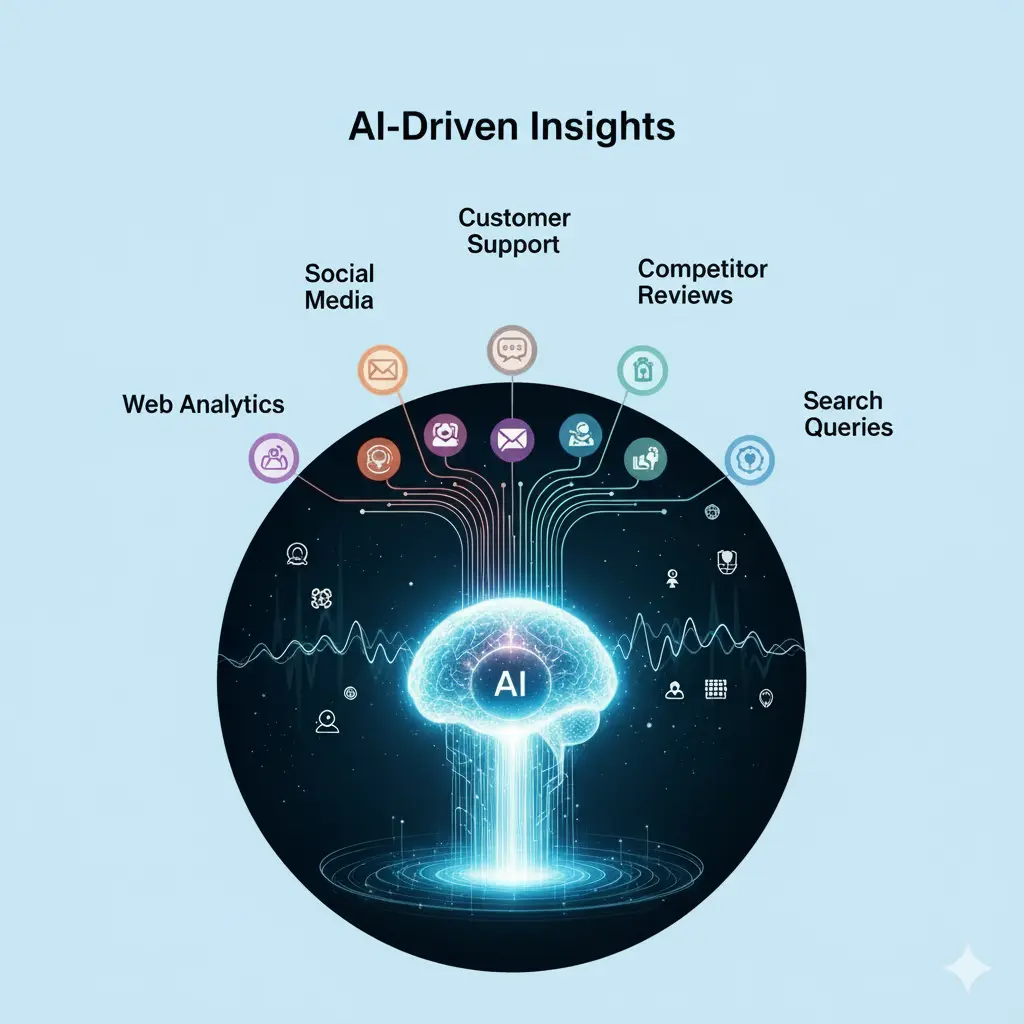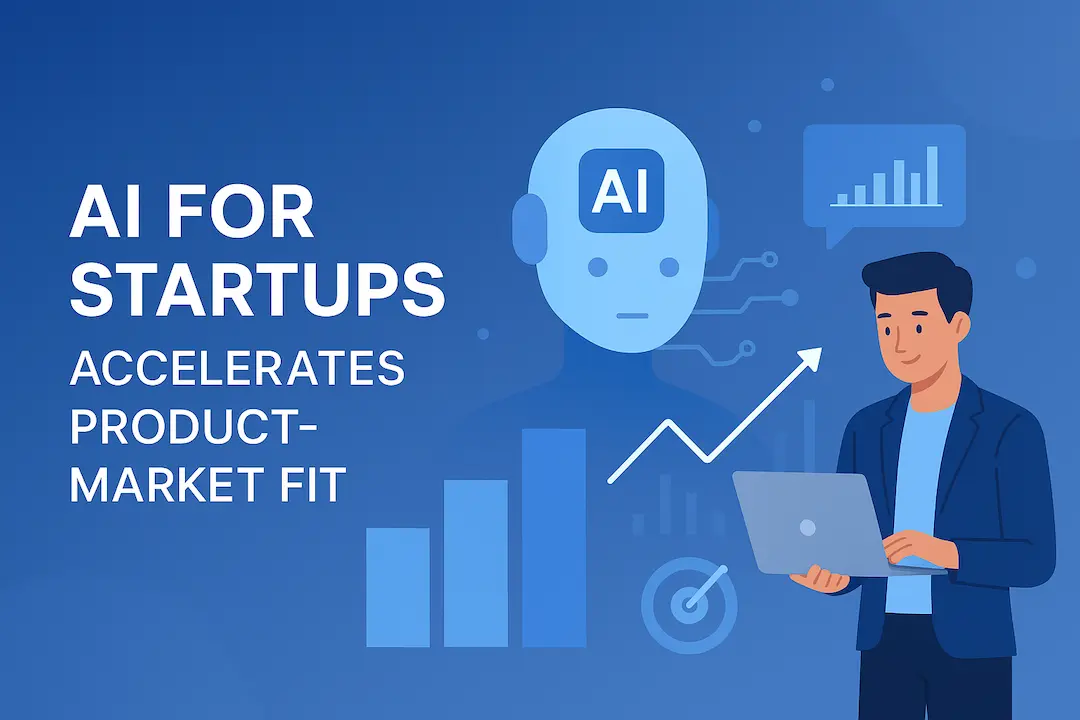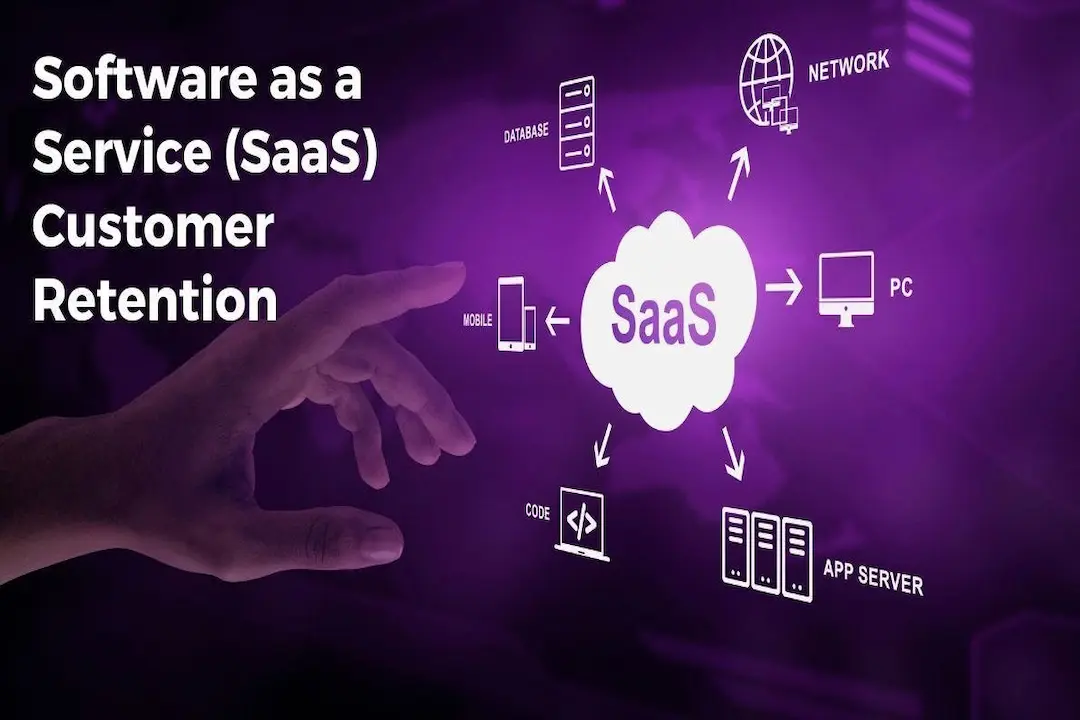
For any startup, the elusive goal of product-market fit (PMF) isn’t just a buzzword; it’s the bedrock of sustainable growth and long-term viability. It’s that magical sweet spot where your product perfectly satisfies a strong market demand, creating a flywheel effect of user acquisition and retention. Historically, achieving this fit has been a painstaking, often trial-and-error process, demanding immense resources, deep market research, and a healthy dose of intuition.
But what if there was a way to accelerate this journey, to decode market signals with unprecedented precision, and to iterate on your offering with scientific rigor? Enter Artificial Intelligence (AI). AI is rapidly transforming how startups approach PMF, offering powerful tools to unearth insights, streamline development, and gain a critical edge in today’s hyper-competitive landscape. From sophisticated business artificial intelligence software to specialized AI for product development platforms, these technologies are no longer futuristic concepts but essential drivers for success.
However, the true power lies not just in deploying AI, but in finding the optimal balance between its analytical prowess and indispensable human oversight. This article will guide small business owners in the tech sector, marketing professionals, and enterprise IT decision-makers through the intricate dance of leveraging AI to achieve product-market fit, ensuring your innovation doesn’t just launch, but truly thrives.
Table of Contents
Understanding Product-Market Fit
Before we dive into the AI revolution, let’s solidify our understanding of what product-market fit truly entails. It’s more than just having a good product; it’s about having the right product for the right audience at the right time.
Definition of Product-Market Fit
At its core, product-market fit means being in a good market with a product that can satisfy that market. Marc Andreessen, co-founder of Andreessen Horowitz, famously articulated it as: “You can always feel product-market fit when it’s happening. The customers are buying the product just as fast as you can make it – or the usage is growing just as fast as you can add servers. Money in the bank account. Customers are happy to pay. Happy customers tell other happy customers.”
It’s a state where:
- Customers enthusiastically adopt your product. They see it as solving a real, urgent problem.
- Retention is high. Users stick around because they find continuous value.
- Word-of-mouth is strong. Users become advocates, driving organic growth.
- Market size is significant. There’s a substantial audience willing and able to pay.
- Growth is rapid and sustainable. You’re not just acquiring users, but retaining them efficiently.
Achieving PMF is critical because it signals that your startup has found a repeatable, scalable business model. Without it, even the most innovative ideas can wither, trapped in a cycle of high churn and unsustainable marketing spend. It’s the difference between a fleeting experiment and a lasting enterprise.
The Challenges Startups Face
The journey to PMF is fraught with obstacles. Many promising startups falter not due to a lack of effort or ingenuity, but because they misinterpret market signals or fail to adapt quickly enough. Common challenges include:
- Lack of Actionable Market Data: Startups often operate with limited budgets for extensive market research, leading to assumptions rather than data-driven decisions. What customers say they want isn’t always what they do.
- Shifting Consumer Preferences: Markets are dynamic. User needs, technological trends, and competitive landscapes evolve rapidly, making it difficult to pinpoint a stable “fit.”
- Resource Constraints: Small teams juggle multiple responsibilities, making it challenging to dedicate sufficient time to deep market analysis, user feedback loops, and rapid product iteration.
- Confirmation Bias: Founders and teams can become overly attached to their initial vision, inadvertently ignoring feedback that contradicts their assumptions.
- Competitive Saturation: In many tech sectors, markets are crowded. Standing out requires a profound understanding of niche demands and unique value propositions.
- Inefficient Iteration: Traditional product development cycles can be slow, meaning valuable time and resources are spent on features that may not resonate with the target market.
These challenges underscore the need for smarter, faster, and more data-driven approaches – precisely where AI steps in.
The Role of AI in Achieving Product-Market Fit
AI isn’t just a fancy tool; it’s a strategic partner for startups striving for PMF. It empowers businesses to move beyond guesswork, offering capabilities that fundamentally change how market research, product development, and competitive analysis are conducted.

AI-Driven Insights
One of AI’s most profound contributions is its ability to synthesize vast amounts of data into actionable insights, revealing the true pulse of consumer needs and preferences. Instead of relying on small focus groups or intuition, AI ML consulting services and sophisticated platforms can analyze:
- Social Media Conversations: Identifying sentiment, trending topics, pain points, and desires expressed by potential users.
- Customer Support Tickets & Reviews: Uncovering recurring issues, feature requests, and areas of dissatisfaction directly from user feedback.
- Competitor Product Reviews: Pinpointing gaps in competitor offerings and identifying opportunities for differentiation.
- Search Query Data: Understanding what problems users are actively trying to solve online.
- Web Analytics & User Behavior: Mapping user journeys, identifying drop-off points, and understanding engagement patterns within existing products or prototypes.
Example: AuraFlow’s AI-Powered Discovery
Consider AuraFlow, a hypothetical B2B SaaS startup aiming to revolutionize project management for hybrid teams. Initially, their product focused heavily on advanced scheduling algorithms. However, after integrating an AI search app and sentiment analysis tool, they discovered a significant unmet need: seamless asynchronous communication within diverse time zones. The AI analyzed millions of forum posts, support tickets from rival platforms, and public corporate communications, revealing that team leaders struggled most with information silos and context switching in a hybrid environment, not just scheduling. This AI-driven insight led AuraFlow to pivot, prioritizing a “context engine” feature that automatically summarized project updates and identified key decisions, significantly boosting their user engagement and ultimately leading to strong PMF in a specific niche. This illustrates the power of AI in customer service data analysis for product iteration.
Predictive Analytics and A/B Testing
AI elevates product development from reactive adjustments to proactive, data-informed strategy.
Predictive Analytics: This involves using historical data to forecast future outcomes. For startups, AI-powered predictive analytics can:
- Identify potential churn risks: Flag users who are likely to disengage based on their usage patterns.
- Forecast feature adoption: Estimate how a new feature might be received by different user segments.
- Optimize pricing strategies: Predict the optimal price point for various user tiers to maximize revenue and adoption.
- Anticipate market shifts: By analyzing macro trends and competitor moves, AI can provide early warnings of impending changes, allowing startups to adapt their offerings before it’s too late.
This capability is crucial for making informed decisions on where to allocate development resources, refining value propositions, and fine-tuning go-to-market strategies.
A/B Testing: While not new, AI significantly enhances A/B testing, making it more efficient and insightful. Traditional A/B testing can be slow, resource-intensive, and sometimes inconclusive. AI tools can:
- Automate test design: Suggest optimal test variations based on past performance and user data.
- Accelerate result analysis: Quickly identify statistically significant winners and losers, minimizing the time needed to draw conclusions.
- Personalize tests: Run multivariate tests across various user segments simultaneously, tailoring experiences to different user behaviors.
- Identify subtle patterns: Detect nuances in user responses that human analysts might miss, leading to deeper insights into what truly drives engagement.
Stat: Research suggests that startups leveraging advanced A/B testing and predictive analytics can improve conversion rates by upwards of 20-30% and reduce development cycles by 15-25%, directly impacting their speed to product-market fit. (Hypothetical statistic for illustrative purposes).
Gathering Competitive Intelligence
In a crowded market, knowing your competitors is not just good practice; it’s a necessity. AI offers unparalleled capabilities for gathering and analyzing competitive intelligence, helping startups to carve out their unique space. How to conduct competitive benchmarking for generative AI presence is a new, emerging area that highlights the depth of analysis possible.
AI can continuously monitor competitors’ digital footprints, including:
- Product Updates and Feature Releases: Tracking new functionalities, pricing changes, and messaging shifts.
- Marketing Campaigns and Advertising Spend: Understanding their acquisition strategies and key value propositions.
- Customer Reviews and Sentiment: Identifying their strengths, weaknesses, and areas where they might be failing their customers.
- Hiring Trends: Gaining insights into their strategic priorities and technological investments.
- Patent Filings and Investor News: Anticipating future product directions and strategic partnerships.
This real-time, comprehensive view allows startups to:
- Identify Market Gaps: Find underserved niches that competitors are missing.
- Benchmark Performance: Compare their own product features, pricing, and user experience against industry leaders.
- Anticipate Threats: React proactively to new competitive offerings or market shifts.
- Inform Differentiation Strategy: Craft a unique value proposition that truly stands out.
Here are key competitive intelligence metrics that AI can track:
| Metric | Description | AI Application |
|---|---|---|
| Feature Velocity | Rate at which competitors release new features and product updates. | Automated monitoring of product announcements, app store updates, social media. |
| Pricing Strategy Evolution | Changes in subscription models, tier pricing, and promotional offers. | Scraping and analysis of competitor websites and historical data. |
| Customer Sentiment & Reviews | Overall positive/negative feedback, specific pain points, and common praises. | Natural Language Processing (NLP) on review sites, forums, and social media. |
| Ad Spend & Keywords | Competitors’ paid advertising efforts, target keywords, and messaging. | Ad intelligence tools, keyword analysis platforms. |
| Market Share Trends | Estimated market penetration and growth within specific segments. | Data aggregation from financial reports, industry analyses, public data sets. |
| Tech Stack Analysis | Technologies used by competitors for their products and operations. | Website scanners, recruitment data, public API analysis. |
This systematic approach, powered by AI, transforms competitive analysis from an occasional audit into a continuous, strategic advantage.
The Balance of Human Oversight and AI
While AI offers revolutionary capabilities, it’s not a silver bullet. The most successful startups understand that AI is a powerful enabler, not a replacement for human ingenuity, empathy, and ethical judgment. The optimal strategy lies in creating a synergistic relationship between machine intelligence and human wisdom.
Importance of a Human Touch
AI excels at processing data, identifying patterns, and making predictions based on algorithms. However, it lacks:
- Intuition and Creativity: The ability to generate truly novel ideas or connect seemingly unrelated concepts in a groundbreaking way.
- Empathy and Contextual Understanding: Machines don’t understand the nuances of human emotion, cultural context, or unspoken needs that often drive purchasing decisions.
- Strategic Vision: While AI can inform strategy, the overarching vision and long-term direction of a startup must come from human leadership.
- Ethical Reasoning: AI can follow rules, but humans must define what those rules are and why they matter.
For instance, while AI might identify a gap in the market for “personalized financial advice for gig workers,” a human entrepreneur will bring the empathy to understand the unique financial anxieties of this group, the creativity to design a user experience that feels empowering, and the strategic foresight to build a sustainable business model around it. This is where AI consultants can bridge the gap, helping human teams interpret AI outputs effectively. The human touch ensures that product development remains aligned with real-world user needs and values, preventing the creation of technically sound but ultimately unloved products.
Transparency and Ethical Governance
The increasing integration of AI into product development and customer interactions also brings critical ethical considerations to the forefront. As small business owners and IT decision-makers, fostering transparency and implementing robust ethical governance are paramount for building trust with stakeholders and ensuring long-term success. Topics like “is AI bad for society” are valid concerns that need to be proactively addressed.
Key ethical implications include:
- Data Privacy: Ensuring that customer data collected and processed by AI is handled securely and in compliance with regulations like GDPR and CCPA.
- Algorithmic Bias: AI models can inadvertently perpetuate or even amplify existing societal biases if trained on biased data. This can lead to unfair or discriminatory outcomes, for example, in loan applications or hiring tools.
- Transparency and Explainability: Users and stakeholders need to understand how AI makes decisions. A “black box” approach erodes trust.
- Accountability: Establishing clear lines of responsibility for AI-driven decisions, especially when errors occur.
Example: Veridi’s Ethical AI Framework
Veridi, a hypothetical startup offering AI agents development for environmental monitoring, exemplifies a commitment to ethical AI. From its inception, Veridi implemented a transparent AI governance framework. They publicly document their data collection methods, explain the algorithms used for predictive modeling, and regularly audit their AI for potential biases against specific geographic regions or environmental conditions. Their data scientists work closely with ethicists and community leaders to ensure that their AI agents workflow prioritizes accuracy and fairness, rather than just efficiency. This commitment has not only built deep trust with their users and investors but has also positioned them as a thought leader in responsible AI and the future of sustainable technology, proving that ethical AI can be a competitive advantage.
Implications of AI Integration for Startups
Integrating AI into the core operations of a startup has far-reaching implications, extending beyond mere product development to influence decision-making, stakeholder trust, and the very culture of the organization.
Decision-Making and Proactive Adaptation
AI fundamentally transforms how startups make decisions. Instead of relying solely on intuition, anecdotal evidence, or delayed quarterly reports, leaders can leverage AI to:
- Access Real-time, Data-Driven Insights: AI dashboards and alerts provide immediate feedback on product performance, user engagement, and market shifts. This allows for swift, informed adjustments rather than reactive course corrections.
- Simulate Scenarios: Predictive models can run “what-if” analyses, allowing decision-makers to evaluate the potential impact of different strategic choices (e.g., launching a new feature, adjusting pricing, expanding into a new market) before committing resources.
- Identify Emerging Trends: AI can spot nascent patterns in vast datasets that humans might miss, enabling startups to be proactive in adapting their product roadmap and marketing strategies. This is crucial for staying ahead in fast-paced tech environments.
- Optimize Resource Allocation: By understanding which initiatives are most likely to yield positive results, AI helps startups allocate their often-limited capital and human resources more efficiently, maximizing their chances of achieving PMF.
This proactive adaptation, driven by intelligent insights, is a significant competitive differentiator. Startups equipped with AI can pivot faster, innovate more effectively, and respond to market demands with agility that their less technologically advanced counterparts cannot match.
Building Trust with Stakeholders
In the tech sector, trust is currency. For small business owners and enterprise IT decision-makers, fostering transparency in AI applications is vital not only for customer loyalty but also for attracting investors, retaining talent, and building a strong brand reputation.
- Customers: When users understand how their data is used and how AI-powered features enhance their experience, they are more likely to trust the product and the company. Clear communication about AI’s role, privacy policies, and avenues for feedback are essential. Products built with transparent AI software development practices garner greater acceptance.
- Investors: Investors are increasingly scrutinizing a startup’s AI strategy, not just for its innovation potential but also for its ethical implications and compliance readiness. Demonstrating a thoughtful approach to AI governance can instill confidence and make your startup a more attractive investment.
- Employees: A transparent AI strategy fosters an internal culture of responsibility and innovation. Employees are more engaged when they understand the purpose and ethical guidelines of the AI tools they are building and deploying. It also attracts top talent interested in working for companies that prioritize responsible technology.
- Partners and Regulators: Clear documentation and adherence to ethical guidelines simplify partnerships and ensure compliance with evolving regulatory landscapes, mitigating potential legal and reputational risks. The “social impact of AI” is a growing area of concern for all stakeholders.
Ultimately, integrating AI while maintaining a steadfast commitment to transparency and ethical practices builds a foundation of credibility that can significantly strengthen a startup’s position in the market and accelerate its journey to PMF.
Conclusion
Achieving product-market fit is the ultimate quest for any startup, a journey that demands insight, agility, and a relentless focus on the customer. In this era of rapid technological advancement, Artificial Intelligence has emerged as an indispensable ally, transforming the path to PMF from a speculative endeavor into a data-driven science. From unearthing profound AI-driven insights into consumer needs and harnessing predictive analytics for proactive adaptation, to gathering real-time competitive intelligence, AI empowers startups to navigate complex markets with unparalleled precision.
However, the true mastery lies not in simply deploying AI, but in forging a symbiotic relationship between machine intelligence and the irreplaceable human touch. It’s the human capacity for empathy, creativity, and ethical judgment that ensures AI’s power is channeled toward building products that are not only effective but also responsible and truly beloved by users. For small business owners, marketing professionals, and IT decision-makers, embracing AI with a balanced, human-centric approach is no longer an option but a strategic imperative. It’s about building trust, fostering transparency, and ultimately, unlocking sustainable success in a rapidly evolving digital world.
Ready to turn insights into impact? At Webologists, we specialize in helping startups harness the power of AI to accelerate product-market fit, optimize decisions, and outpace competitors. Whether you’re exploring predictive analytics, smarter A/B testing, or AI-driven market research, our experts can guide you every step of the way. Let’s transform your data into a growth engine — partner with us today and build a product your customers truly love.
FAQs
-
What is Product-Market Fit (PMF) and why is it crucial for AI startups?
PMF is the ideal state where your product effectively satisfies a significant market demand, creating a foundation for sustained growth. For AI startups, achieving PMF isn’t optional; it’s vital for survival, ensuring your innovative solution truly connects with user needs and avoids high churn.
-
How does AI itself accelerate the process of achieving Product-Market Fit?
AI significantly speeds up PMF by enabling rapid product iteration and pinpointing user needs with data-backed insights. It leverages automated data analysis, predictive analytics for feature prioritization, and real-time A/B testing to quickly adapt and optimize AI products for the market.
-
What are the dangers for founders who misinterpret early positive traction as true PMF?
Misinterpreting early traction from niche users or enthusiasts can lead to overconfidence and a false sense of PMF. This optimism bias risks wasting resources, delaying crucial strategic shifts, and ultimately imperiling the startup’s future due to a lack of genuine, scalable market demand.
-
How should AI founders effectively measure Product-Market Fit for their unique products?
AI founders should track metrics beyond basic engagement, focusing on AI feature adoption rate, the accuracy and relevance of AI outputs, and the time-to-value users gain from AI. It’s crucial to also assess user disappointment if AI features were removed and the efficiency gains provided by the AI system.
-
Should AI founders view Product-Market Fit as a fixed destination or an evolving process?
PMF is a continuous spectrum, not a one-time achievement. AI founders must constantly evaluate and adapt their products due to dynamic markets, evolving user expectations, and rapid technological advancements, ensuring their AI solutions remain relevant, valuable, and competitive over time.





